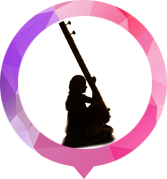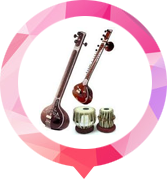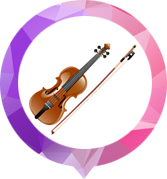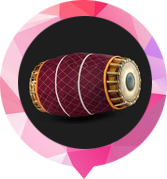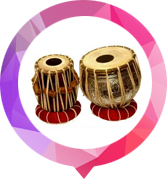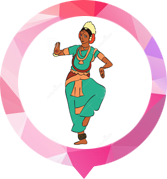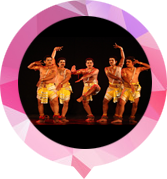Introduction
As per shastras, Music has evolved from Samaveda, which is a part of Rig Veda. It also has references in epics like Ramayana and Mahabharata and various other sacred scriptures. Many saints and scholars believe that music is the greatest form of penance and the easiest way to reach God or to attain salvation or moksha. Music has been divided into two systems namely- Swara Sampradaya system and Raga Sampradaya system. Swara Sampradaya system is pure and sheer swara which has no gamakas (oscillation of a note) and Raga Sampradaya system has many rules and regulations to sing a notation. Western music is mostly considered as Swara Sampradaya system whereas Indian music follows Raga Sampradaya system, which fully consists of bhava.
Indian classical music has been divided into two categories:
1. Carnatic Music
2. Hindustani Music
Carnatic music is mostly sung in Southern India whereas Hindustani is popular in Northern India. The demarcation between both the forms of music was clearly stated between 14th and 15th century AD.Carnatic Music
Great scholars such as Bharata, in his Natya Shastra, also acknowledges that music belongs to Gandharvas.
Bharata
Natya Shastra
Matanga
Brihaddeshi
Jayadeva
Geetagovindam
Sarangadeva
Sangeeta Ratnakara
Narada
Swararnavam
Vidyaranya
Sangeeta Sara
Ramamatya
Swaramela Kalanidhi
These scriptures have shaped the present day Carnatic music. Many great vaageyakaras such as Annamacharya, Purandaradas, Bhadrachala Ramadasu, the music trinity- Thyagaraja, Muthuswamy Deekshitar and Shyama Sastri have contributed a lot towards the development of Carnatic music through their compositions. Purandaradas has his own prominence in Carnatic music as he formed the basics or preliminary exercises of Carnatic music.
Not only vocal, but Carnatic music includes various instruments such as Veena, Flute, Violin, Mridangam, Nadaswaram, etc.
Hindustani Music
Hindustani classical music is the Hindustani or North Indian style of Indian classical music. The style is sometimes called North Indian classical music or Shāstriya Sangīt. It is a tradition that has been evolving since the 12th century CE, in North India.
It is a tradition for performers who have reached a distinguished level of achievement to be awarded titles of respect; Hindus are usually referred to as pandit and Muslims as ustad. An aspect of Hindustani music going back to Sufi times is the tradition of religious neutrality: Muslim ustads may sing compositions in praise of Hindu deities, and vice versa.
Around the 12th century, Hindustani classical music diverged from what eventually came to be identified as Carnatic classical music. The central notion in both these systems is that of a melodic mode or raga, sung to a rhythmic cycle or tala. These principles were refined in the musical treatises Natya Shastra, by Bharata (2nd–3rd century CE), and Dattilam (probably 3rd–4th century CE).
In medieval times, the melodic systems were fused with ideas from Persian music, particularly through the influence of Sufi composers like Amir Khusro, and later in the Mughal courts. Noted composers such as Tansen flourished, along with religious groups like the Vaishnavites. After the 16th century, the singing styles diversified into different gharanas patronized in different princely courts. Around 1900, Vishnu Narayan Bhatkhande consolidated the musical structures of Hindustani classical music, called ragas, into a number of thaats. Indian classical music has seven basic notes with five interspersed half-notes, resulting in a 12-note scale. Unlike the 12-note scale in Western music, the base frequency of the scale is not fixed, and intertonal gaps (temperament) may also vary; however, with the gradual replacement of the sarangi by the harmonium, an equal tempered scale is increasingly used. The performance is set to a melodic pattern called a raga characterized in part by specific ascent (aroha) and descent (avaroha) sequences, which may not be identical. Other characteristics include "king" (vadi) and "queen" (samavadi) notes and characteristic phrases (pakad). In addition each raga has its natural register (ambit) and portamento (meend) rules. Performances are usually marked by considerable improvisation within these norms.
The major vocal forms or styles associated with Hindustani classical music are dhrupad, khyal, and tarana. Other forms include dhamar, trivat, chaiti, kajari, tappa, tapkhyal, ashtapadis, thumri, dadra, ghazal and bhajan; these are folk or semi-classical or light classical styles, as they often do not adhere to the rigorous rules of classical music.
Its main instruments are Sitar, Tabla, Sarangi, Harmonium, Been, etc.
Indian Classical Dance
Indian Classical Dance has been divided into three fundamental parts- Naatya, Nrutya and Nritta. Nrutya adds a dimensions, which is expression. Nritta is sheer rhythmic dance.
Indian classical dance, or Shastriya Nritya, is an umbrella term for various performance arts rooted in religious Hindu musical theatre styles,whose theory and practice can be traced to the Sanskrit text- Bharata’s Natya Shastra.
The number of recognized classical dances range from eight to more, depending on the source and scholar. The Sangeet Natak Akademi recognizes eight – Bharatanatyam, Kathak, Kuchipudi, Odissi, Kathakali, Sattriya, Manipuri and Mohiniyattam. Scholars such as Drid Williams add Chhau, Yakshagana and Bhagavata Mela to the list. The Culture Ministry of the Government of India includes Chhau in its classical list. These dances are traditionally regional, all of them include music and recitation in local language or Sanskrit, and they represent a unity of core ideas in a diversity of styles, costumes and expression.
Kuchipudi Dance
Kuchipudi is a dance-drama performance art, with its roots in the ancient Hindu Sanskrit text of Natya Shastra.It developed as a religious art linked to traveling bards, temples and spiritual beliefs, like all major classical dances of India.Evidence of Kuchipudi's existence in an older version are found in copper inscriptions of the 10th century, and by the 15th century in texts such as the Machupalli Kaifat.Kuchipudi tradition believes that Tirtha Narayana Yati – a sanyassin of Advaita Vedanta persuasion, and his disciple an orphan named Siddhendra Yogi founded and systematized the modern version of Kuchipudi in the 17th century. Kuchipudi largely developed as a Hindu god Krishna-oriented Vaishnavism tradition,and it is most closely related to Bhagavata Mela performance art found in Tamil Nadu.
The Kuchipudi performance usually begins with an invocation. Then, each costumed actor is introduced, their role stated, and who then performs a short dance prelim to music (dharavu). Next, the performance presents pure dance (nritta). This is followed with expressive part of the performance (nritya), where rhythmic gestures as a sign language mime the play. Vocalists and musicians accompany the artist, with the song recited in Telugu language, and the tala and raga set to (Carnatic music). The typical musical instruments in Kuchipudi are mridangam, veena, flute and the tambura.
One of the most prominent artists was the legendary Vempati Chinna Sathyam. With his outstanding creativity and brilliant choreography, he spread the art form across India and abroad. His brother Vempati Pedda Sathyam, Pasumarthi Krishnamurthy and Vedantam Jagannatha Sarma, followed another pioneer, Vedantam Raghavaiah, to Chennai and took this sensuous art to the film industry. They choreographed Kuchipudi-based dance sequences for many Telugu movies.
Perini Dance
Perini Shivatandavam (Perini Śivatandavam) or Perini Thandavam is an ancient dance form from Telangana which has been revived in recent times. It originated and prospered in Telangana during the Kakatiya dynasty.Perini is performed by males and it is believed that in ancient times this was performed before the soldiers set to war. Nataraja Ramakrishna was the person who revived this art form recently.Perini Dance form was developed at the time of Ganapathi deva, the king of Kakatiya Empire.

